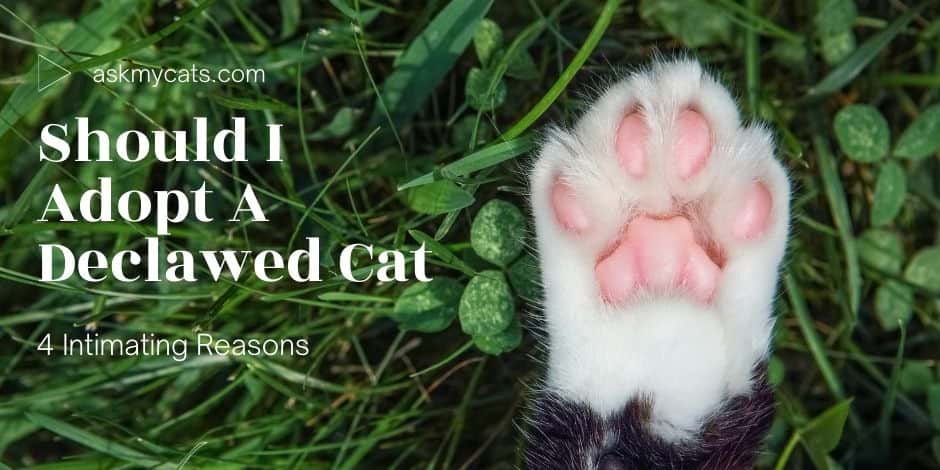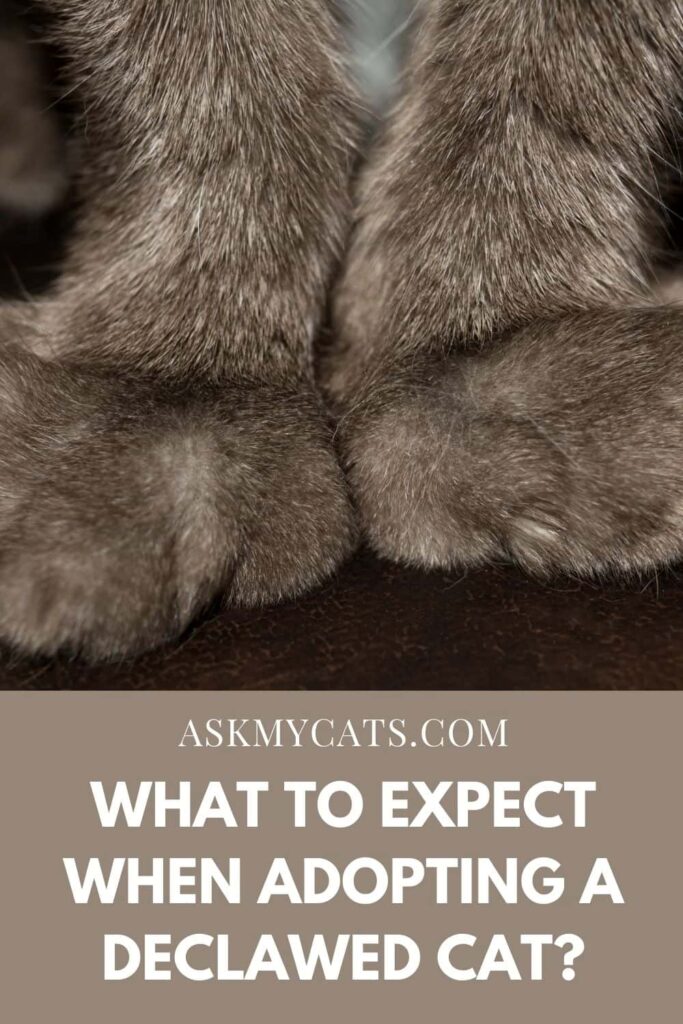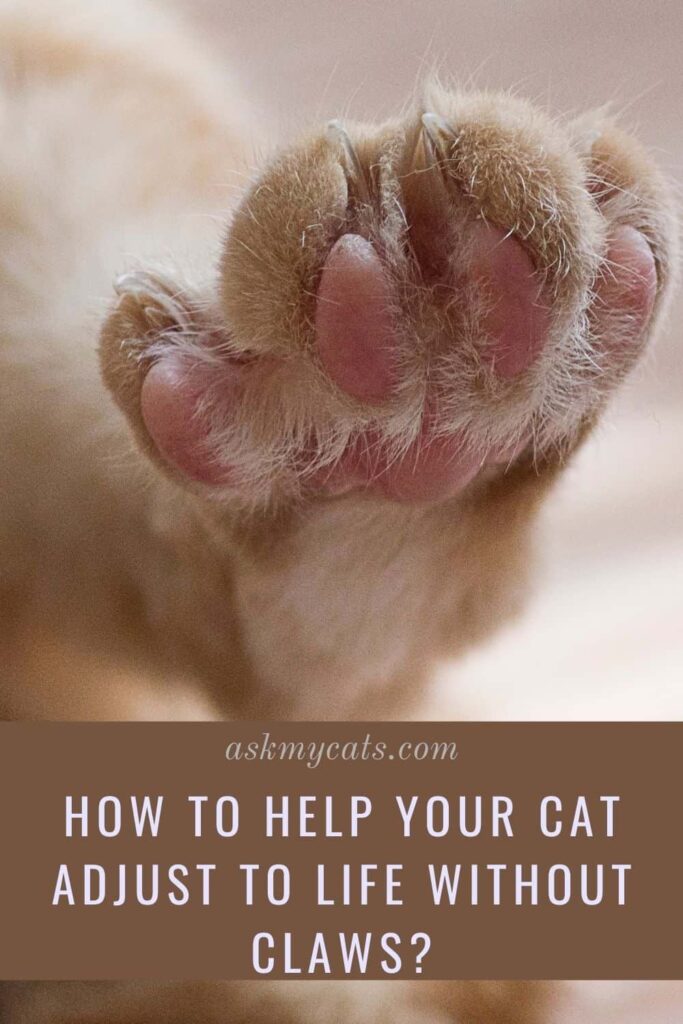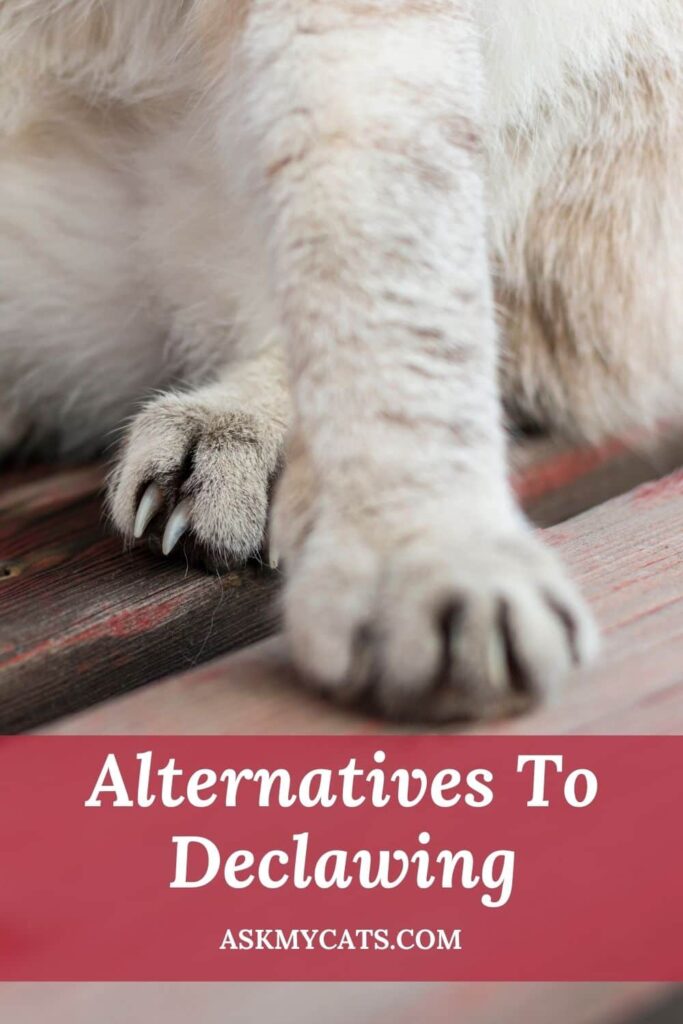Although the paws of a cat do not sound like this big deal for you, they affect you a lot in the feline world, from health to actions. Therefore, before taking it to your house, it is important that you read all the facts about announced kitties.
Many rescues today, only adopt cats into homes that contractually agree to not declaw the adopted cat in the future.
Declawing is a traumatic, dangerous operation and is only performed for human convenience. In situations where paws are medically damaged, declawing cats should be considered anything but barbaric.
Declawing is one of the known techniques by veterinarians and was considered an appropriate way to prevent cats from destroying furniture, scratching their family members or other pets, and keeping them from attacking other small animals that got into the house.
For cats, declawing can affect a lot, from health to behavioral patterns. Because of this, it is crucial to learn all the facts on declawed kitties when you bring one into your home.
So, to understand better let’s ask a question ourselves: what is declawing? should we adopt one of them? And what are the side effects?
Many vets and rescue groups have stopped offering the declawing procedure or allowing this practice in recent years after knowing about the related side effects.
You may adopt a declawed cat to help his suffering and you may be able to nurture them into a well-groomed cat in course of time.
Unfortunately, this is not a global, or even national standard, yet. Although declawing has been outlawed in 22 countries worldwide, in America, between 20 and 25 percent of all cats have been declawed, according to BBC World News.


Give Your Cat the Perfect Day
Get the Free Ebook!
What Is Declawing?
A declaw is the surgical removal, under anesthesia, of a cat’s claws. In order to ensure that they don’t grow back, amputation must be done on each toe, down to the first joint.
The procedure may be done with a scalpel blade, a guillotine-type nail trimmer, or a laser.
Cats that are declawed, experience 10 separate amputations (if only the front claws are removed: 18 if the back toes are also declawed).
The cats are then expected to walk, run, and climb on these amputations and use a litter box, where the incisions are exposed to urine, feces, and litter. There are also risks associated with anesthesia and bleeding during the procedure.
What To Expect When Adopting A Declawed Cat?
The Animal Advocacy group called PAWS explains some of the issues in declawed cats on their blog:
“Groomers, veterinarians, and people who care for declawed cats in shelters find many of them to be nervous, irritable, and difficult to handle.”
~(PAWS.org)

Without their claws, cats can get easily stressed and feel vulnerable.
They may withdraw, hide, or compensate for their lack of claws with other defense mechanisms.
These can include biting and raising their vocals.
Declawed cats may avoid their litter box as they start to feel uncomfortable or even in pain.
Without claws they cannot get as clean and stepping on the litter can be particularly sensitive.
If you are interested in adopting a cat that has been declawed, be aware of their extra challenges.
- Speak with a veterinarian about any changes in their diet or routine before implementing them. As with any cat, take your time and build a relationship of trust.
- Cats without claws still need to exercise and play, but they cannot do most things the same. They play with toys by wrapping their whole paws or whole body around it or pouncing fully on things.
- Ask the rescue or foster group about behavioral issues that the cat may have already displayed.
- Be honest and realistic about the commitment you can make to a cat, and what your home life is like. Cats can be trained out of negative or aggressive behaviors, but it takes time and patience. Positive reinforcement and repetition are essential.
What Challenges Cat Will Face After Declawing?
Once a cat goes home following a declaw surgery, the cat must endure the pain of walking on the surgical sites.
He/she may not move around much, becoming depressed and suffering in silence.
Other cats may elect to continue playing and running as they normally would, not able to understand that these things result in pain, and these cats are at even greater risk of having their incisions break open.

1. Outdoors:
Cats use their claws for protection. Without claws, a cat is essentially defenseless in a fight.
Because of this, you want to keep your cat indoors 100 percent of the time for her own safety.
Your cat would be helpless if attacked by clawed cats, dogs, or other animals.
2. Litter Box Training:
Cats that have just been declawed often have litter box problems because it hurts them to scratch around in the litter.
Litter box issues present a unique concern following declaw surgeries.
Because many regular litter types have small particles that could enter a cat’s toe incisions, causing irritation and infection, paper litter is often recommended for a period of time.
Paper isn’t a substrate that most cats are used to using as litter, so it’s common for cats to begin urinating outside of the litter box when it is used.
Cats may also urinate inappropriately following declaw surgery because they experience pain from their paws when they get in the litter box and paw around.
These litter box problems may follow a cat throughout his life, causing him to be at risk for abandonment or worse.
3. Temperament:
It will be sensitive on its front feet (assuming only the front declawed). It probably won’t like you playing with its toes or holding its paws, and might be really aggressive about telling you so (biting, hissing, whacking you).
Be understanding about behavioral and temperament issues with your new declawed cat in your home.
When a cat suddenly doesn’t have their main form of defense and protection, she/he might have a more anxious, scared, and on-edge temperament than other felines. Patience is key in these situations.
If at first, your new cat doesn’t trust you, give her some time and love.
4. Claw Growth:
If for any reason the declawing surgery was done incorrectly, your cat might experience regrowth of the claws. This is especially possible if you adopted a feline who’d recently been declawed.
When regrowth occurs, the claws generally do not grow back normally, and they tend to be deformed. The new claws also usually put your little one in pain.
Be on the lookout for signs of this problem in your kitty, and if you notice anything, take her to the veterinarian immediately.
You might also like to read about do cats claws grow back
5. Balance Is Disrupted
Declawing can cause them to be more prone to falling injuries. Cats are digitigrade walkers.
This means that cats walk on and balance with their toes rather than the bottoms of their feet, like plantigrade walkers such as humans.
It may not like having its tummy rubbed (some cats actually do like this). Not having claws makes cats insecure, and letting a person rub their tummies requires a level of trust declawed cats may not be able to give.
How To Help Your Cat Adjust To Life Without Claws?

- If your declawed cat shows signs of pain, limping, or lameness, you can try different types of massage on their paws or legs.
- Remember that cats will try to hide the pain. Declawed cats adjust their walk to redistribute their weight or avoid pain the same way that humans may change the way they walk after an injury.
- Depending on how recently the surgery occurred, you may need to keep an eye on the wounds to assure that the wounds heal correctly and do not become infected.
- If the pain or limping continues, discuss oral or related painkillers with your cat’s vet. You can also proactively add supplements to their diet to prevent them from arthritis.
- Limit the amount of grain and carbs in your cat’s diet and ensure that they get exercise and mental stimulation every day.
- Offering a scratching post may seem to lead to the expectation, but it allows your cat to stretch, play, and may let them mark it as part of their territory in the home.
- Offering kickers or larger toys can help redirect their biting instincts. Wiggling the stick end of pole toys under a blanket or pillow allows your cat to jump on top of it safely.
- If they are struggling to use the litter box, consult first with a veterinarian to make sure there are no other medical issues at hand. Try to slowly change their litter to a soft, scoopable type instead of anything large or coarse. Assure that the box is easily accessible and that there is at least one box on each level of the home.
- If you find that your declawed cat often relieves itself on your den rug, don’t get upset by her new habit. Just understand that you might have a little bit of training work ahead of you.
Alternatives To Declawing
Cats need claws for balance, self-defense, and survival- especially if they spend any time outdoors. Pet owners considering declawing should know that there are many alternatives.

1. Trim Nails
You can clip your cat’s nails once every couple of weeks or whenever they get too sharp for your liking. This may take some getting used to on your part and on the part of your cat.
If you start making nail trims part of their routine when they are young, you are less likely to face resistance as they get older.
If you are uncomfortable clipping your cat’s nails yourself, many groomers and vet offices will take care of it for a small fee or as part of exams.
2. Nail Caps
You can also apply nail caps onto your cat’s claws. These are rubber or plastic covers that make a cat’s claws duller and softer, though they do require trimming of the claws.
Caps are applied with animal-safe glue applied to the nail. These caps do not prevent claws from retracting, they should not do damage to the claw of the paw itself, and they do not stop the cat from playing and climbing normally.
But if your cat does show some retracting issues, I must suggest you consult your vet and for more information visit our recent article: Cat’s Claws Not Retracting? 3 Must Know Reasons.
3. Clawing Articles
Providing cats with many scratching posts in different areas of your home increases the likelihood that your furniture and carpeting will be left alone.
If your cat is already using an inappropriate object or place to scratch, examine it to gain valuable information.
Is the scratch marks high or low, on a vertical or horizontal surface, in a corner, or under a bed? You can use this data to help you choose the type and placement of scratching posts and pads.
Cats like to scratch on vertical surfaces, horizontal surfaces, and angled surfaces. Sometimes they enjoy finding places to scratch in special areas such as under the bed or in the closet.
4. Behavior Training
Finally, behavior training and environmental adjustments may help. You can train cats not to scratch furniture or family members by applying furniture covers, sprays, or pheromones that will help calm them down.
Make sure to read the labels of the sprays you use and avoid using anything with citrus as an ingredient. Citrus is toxic to cats and can be found in many cleaning agents and home fragrances.
FAQS
How to introduce a declawed cat to other animals?
If you have other animals in your home, proceed with caution when you introduce the newbie, just like you would with any other pet. Go through the introduction process slowly and gradually, and always monitor their interaction closely. In general, declawed cats can live harmoniously and happily with even-tempered dogs and clawed cats. The introduction is key, however. If possible, always keep a barrier between your pets during the first meeting. If your pets behave calmly, reward all of them with yummy treats. If you notice even a hint of aggressive feelings from any party, separate everyone immediately and try again the next day.
Are claw caps safe for cats?
It is safe for cats because it covers the sharp nail inside and mostly the caps are made from silicon and vinyl so that they won’t hurt them. In case of ingestion of the cap, call your local vet ASAP. Mostly they don’t chew or ingest them but if it happens it is an immediate call for a vet.
What is the right technique for clipping a cat’s nail?
It depends on the cat’s nature and their trust in you, mostly what you can do is to calm them and make them agree on clipping. If they agree then the process can go smoothly. If not, then don’t force them. Let them free to have their nails if they don’t want to clip them.
How can I encourage my cat to scratch on the scratching post?
Demonstrate your scratching technique on the scratching post to encourage them to do or if you have other cats then let them scratch it to show an example. You can also encourage them by playing with them using the scratching post.
Can claw caps deform a cat’s nail?
No, actually caps are glued with a weak adhesive substance so that it’ll gradually fall off from the nail while growing and because the materials which are used to produce this product are soft for the nail.
Is it bad to adopt a declawed cat?
Said another way, declawed cats had no problem with their adoption. A lot of blogs and based on anecdotal evidence the implication is that declawed cats are more vulnerable to biting and even to improper removal, which is usually untrue.
Can declawed cats be happy?
It is appealing to them. All this and their integral method of motion, equilibrium, and protection are stripped away by declawing, says the veterinarian. Most declawed cats finally adopt, more or less.
Is it OK to let a declawed cat outside?
A proclaimed cat cannot go outdoors at all so he has no means of defending himself in case any animal strikes or gets lost. An adult cat who is accustomed to exit may find it hard to transition to becoming an indoor pet alone.
What age is best to declaw a cat?
The easiest way to declaw is when the cat is under the age of 6 months. New, non-mature cats less than 6 months recover easily; have the lowest discomfort and the lowest chance of complications.
Are declawed cats always in pain?
The cat’s going to be in agony right after being declawed. Medicine for treating acute pain is prescribed by Vets. Blood, swelling, and inflammation may also occur. One survey reveals that 42% of proclaimed cats have long-term suffering, and almost a quarter of declared cats have been limped.
Do declawed cats live shorter lives?
No cat will be harmed by declawing. The veterinary car lack will however shorten the life of the animal. The declared cats prefer to bite as the regular first scratch defense was removed.
Can declawed cats climb fences?
Cats scale the trees or hop onto fences while they are outside to escape dangerous predators. When they are announced, cats appear less likely to ascend, but they cannot climb. There was a mistake. Declassed cats may use the energy from a long time to propel a tree or fence.
Final Word
Declawing a cat is probably the cruelest thing humans do to cats under the guise of “veterinary care”. I think it should be illegal in the US. It’s not just clipping a claw extra close.
It’s removing the entire distal phalangeal joint from the toe. Imagine cutting off the last joint of your fingers because you don’t want to waste time trimming your nails — That’s what declawing is.
If you do get a chance to adopt a declawed cat, please, do so. Try to show them that it is possible to trust humans again. And promise to never let them outside.
Declawing is a painful, risk-filled procedure that is done only for the convenience of humans. There are only extremely rare instances, when claws are affected by a medical condition, that declawing cats can be considered anything but inhumane.
Fortunately, there are alternative methods for dissuading cat scratching damage to your home. These methods are positive, and humane, and they really work.
